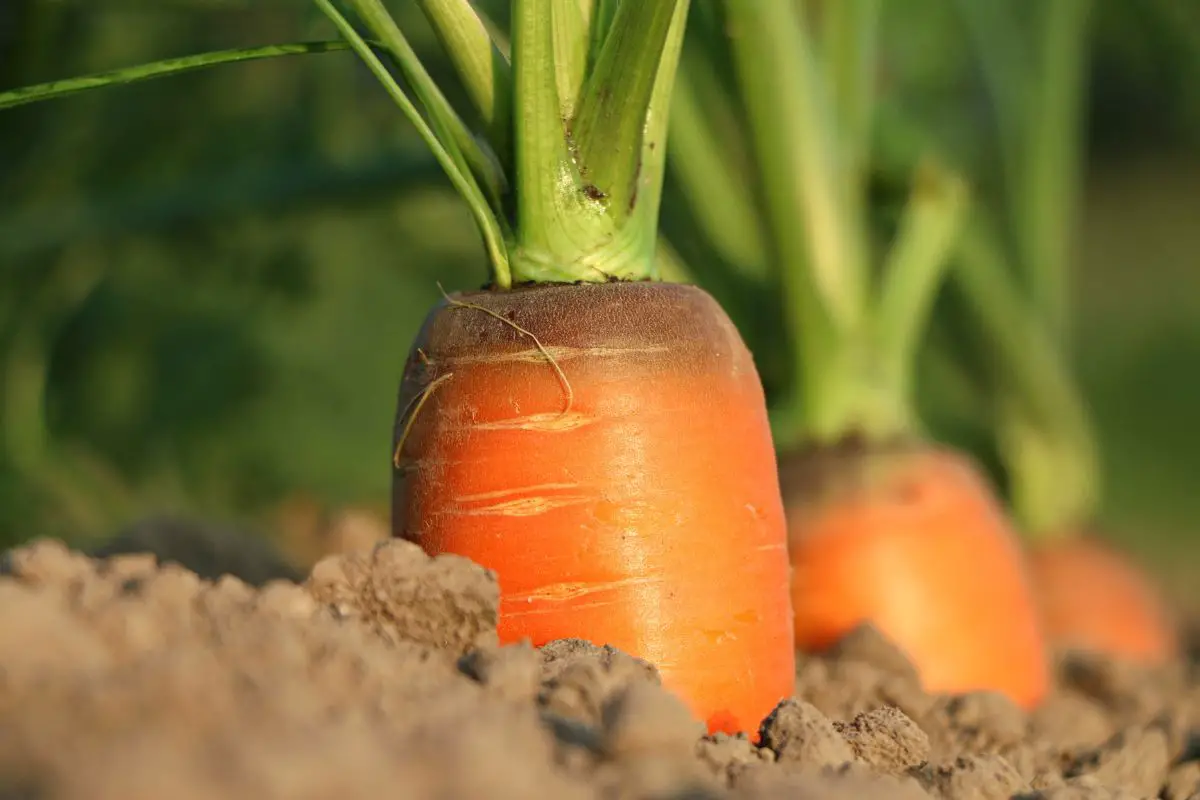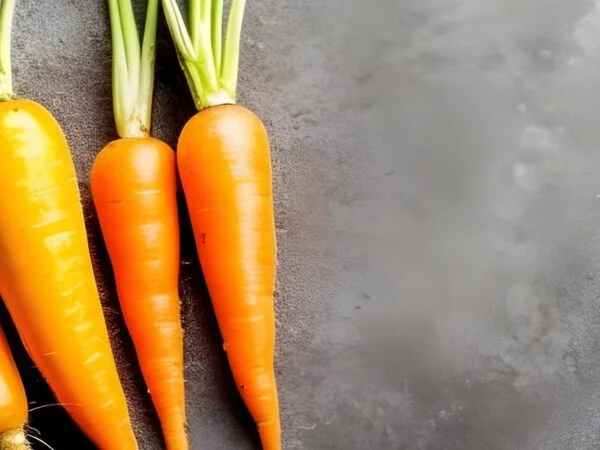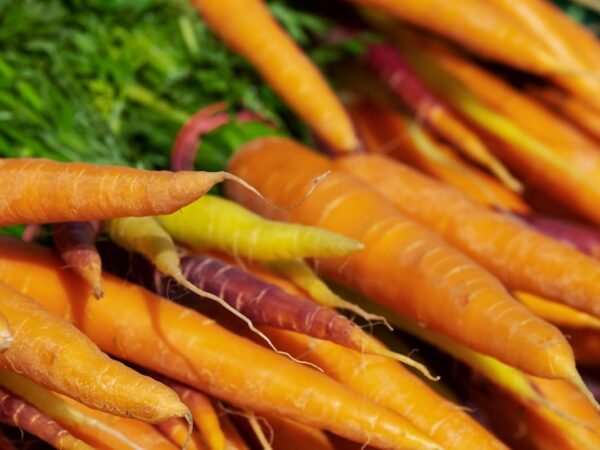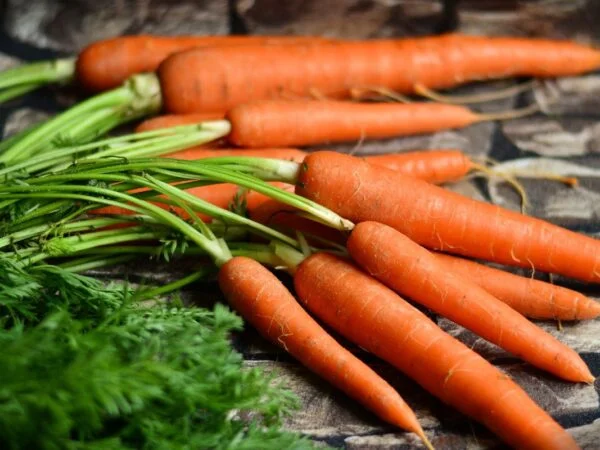
"Every carrot seed has the potential to grow into a new roots garden project."
If you're looking to embark on a rewarding gardening journey, look no further than your kitchen! Start by planting carrot seeds and caring for carrot plants. You can even grow a new carrot from carrot stumps. In this guide, we will show you how to grow fresh carrots from garden vegetables and seeds, using the scraps of your own kitchen. Discover the garden magic as new roots sprout from these kitchen scraps. Having a kitchen garden is an incredible way to save money and reduce waste, while also experiencing the garden magic of regrowing your own vegetables. You can enjoy the simple joy of regrowing new carrot plants and other vegetables in your kitchen garden.
Imagine transforming those leftover carrot tops and ends into thriving carrot plants that yield new carrots for your kitchen garden. With the garden magic of seeds, you can grow your own garden vegetables and enjoy the satisfaction of harvesting fresh produce from your own backyard. With just a few simple steps, you can turn these discarded carrot stumps into a bountiful harvest of garden vegetables. We'll explore the fascinating process of nurturing garden vegetable carrot seeds, caring for the young garden vegetable plants as they develop, and watching them grow inch by inch until they are ready for harvest.
Get ready to witness the magic of turning humble carrot scraps into vibrant carrot varieties that grace your dinner plate. With the use of seeds, you can transform these scraps into a delicious and colorful addition to your meals.
Can You Grow Carrots from Scraps?
Understand the Potential for Regrowth
So you've just finished preparing a delicious carrot dish, and now you're left wondering what to do with the carrot scraps and seeds. Can you actually grow new carrots from leftover bits and seeds? Well, let's find out!
There is some good news and bad news. The good news is that certain parts of the carrot can indeed be used to grow new plants. The bad news is that not all carrot plants parts are equally effective in producing viable carrot crops.
Carrot Tops: A Green Thumb's Delight?
Carrot tops, also known as carrot greens or foliage, refer to the leafy green part at the very top of a carrot. Many people assume that these vibrant greens can be planted to yield more carrots. However, the reality is a bit different.
While it is possible to plant carrot tops and see some growth above ground, they rarely produce edible roots. Instead, these tops are more likely to focus on developing lush foliage rather than forming robust root systems. So if you're hoping for a bountiful harvest of fresh carrots, planting just the tops might leave you disappointed.
However, this doesn't mean that carrot tops are entirely useless! They can still be utilized in other ways such as adding flavor to stocks or salads.
The Power of Carrot Ends
Now let's talk about another option: using carrot ends or stumps. These are the bottom portions of carrots that usually get trimmed off before cooking or eating them. Unlike carrot tops, these ends have a better chance of regenerating into fully-grown carrots.
To grow carrots from ends, start by placing them in a shallow dish filled with water. Make sure that only the bottom portion touches the water while keeping the rest exposed to air. Over time, you should notice small white roots emerging from the submerged end.
Once the roots have developed, you can transfer the carrot ends to a pot or garden bed with well-drained soil. Plant them about an inch deep and space them a few inches apart. With proper care and watering, these carrot ends should grow into mature plants, eventually producing fresh carrots that you can harvest.
A Continuous Supply of Homegrown Carrots
While regrowing carrots from scraps may not provide an endless supply of homegrown goodness, it's still a fun and sustainable way to make use of what would otherwise be discarded. Plus, it's a great project for kids or anyone looking to try their hand at gardening.
So go ahead and give it a shot! Experiment with regrowing carrot tops for flavorful greens or transform those discarded carrot ends into new edible plants. It may not be foolproof, but who knows? You might just end up with some deliciously homegrown carrots on your plate.
Steps to Regrow Carrot Tops
Growing your own carrots from carrot tops can be a fun and rewarding experience. Not only does it allow you to reduce food waste, but it also gives you the satisfaction of nurturing a plant from its remnants. Follow these easy steps to successfully regrow carrot tops at home and watch them transform into thriving plants.
Follow these easy steps
- Prepare the Carrots: Start by selecting fresh, healthy carrots with their leafy green tops intact. Cut off the top portion of the carrot, leaving about an inch of stem attached to the foliage.
- Water Propagation: Fill a shallow dish or container with water and place the cut end of the carrot top in it, ensuring that only the bottom part is submerged. Make sure not to cover the leaves with water as this can lead to rotting.
- Provide Adequate Light: Place the dish in a location where it will receive plenty of sunlight or bright indirect light throughout the day. Carrot tops require at least 6-8 hours of sunlight daily for optimal growth.
- Change Water Regularly: To prevent bacterial growth and maintain water freshness, change the water every two days or whenever it appears cloudy or dirty.
- Be Patient: It may take some time for new growth to appear from the top of the carrot. Be patient and continue providing proper care and conditions for your carrot tops.
- Transition to Soil: Once roots have developed and new leaves start sprouting, it's time to transplant your carrot tops into soil. Prepare a pot filled with well-draining soil and gently transfer each carrot top, burying it up to where the foliage begins.
- Watering Routine: Keep your newly transplanted carrot tops hydrated by watering them regularly, ensuring that the soil remains moist but not overly saturated.
- Provide Nutrients: As your carrot tops continue to grow, they will benefit from a balanced fertilizer. Apply a slow-release fertilizer according to the package instructions to provide essential nutrients for healthy foliage development.
- Monitor Growth: Regularly check the progress of your carrot tops and monitor their growth. Trim any yellowing or damaged leaves to promote new growth and maintain plant health.
- Harvest Time: After several weeks of nurturing your carrot tops, you can harvest the tender young leaves for use in salads or as a garnish. Simply snip off the desired amount, leaving some leaves behind for continued growth.
By following these steps, you can successfully regrow carrot tops and enjoy the satisfaction of growing your own plants from kitchen scraps. Remember to be patient and provide proper care, and soon you'll have vibrant green foliage sprouting from what was once just a discarded carrot top.
Planting Carrot Tops for Regrowth
To ensure optimal growth, it is crucial to select the right soil and container size, provide adequate watering and sunlight, and choose the appropriate time and location for planting.
Choose the Right Soil and Container Size
When regrowing carrot tops, it's essential to use well-draining soil that is rich in organic matter. A mixture of potting soil and compost works best. Avoid heavy clay soils as they can hinder root development.
Consider the container size for your regrown carrot tops. A deep container is ideal since carrots have long taproots that require ample space to grow downwards. Ensure that the container has drainage holes to prevent waterlogging.
Provide Effective Watering and Sunlight Requirements
Watering is a critical aspect of caring for regrown carrot tops. Keep the soil consistently moist but not overly saturated. Aim to water them every few days or whenever the top inch of soil feels dry. Be mindful not to overwater as this can cause rotting.
Sunlight is another vital factor in successful regeneration. Place your carrot tops in a location that receives at least six hours of direct sunlight daily. If you don't have access to sufficient sunlight, consider using a grow light or placing them near a south-facing window.
Determine When and Where to Plant Your Regrown Carrot Tops
Timing plays a crucial role when planting regrown carrot tops outdoors. Wait until after the last frost date in your area before transplanting them outside. Carrots are cool-season crops that thrive in temperatures between 60-70°F (15-21°C).
Choose a suitable spot in your garden that receives full sun or partial shade throughout the day. Ensure that the soil is loose, free from rocks, and well-drained.
Alternatively, if you lack outdoor space or live in an urban setting, you can grow your regrown carrot tops indoors. A windowsill garden can be a perfect solution. Simply place your container near a sunny window and follow the same care instructions as mentioned earlier.
Benefits of Regrowing Carrots from Carrots
Growing your own carrots from scraps offers a multitude of benefits that go beyond just having a fresh supply of delicious and nutritious produce. By regenerating carrots, you not only reduce food waste but also contribute to a more sustainable environment. Let's explore the advantages in detail:
Environmental Advantages of Reducing Food Waste through Regeneration
When you regrow carrots from their scraps, you actively participate in reducing food waste. Instead of discarding carrot tops or peels, which would typically end up in landfills, you give them a second life by allowing them to sprout and grow into new plants. This simple act helps minimize the amount of organic waste that decomposes and produces harmful greenhouse gases like methane.
By embracing the practice of regrowing carrots, you join the movement towards sustainability and environmental consciousness. It's like hitting two birds with one stone - enjoying homegrown goodness while doing your part in combating food waste.
Constant Supply of Fresh Produce
One significant advantage of growing your own carrots is the ability to have a constant supply of fresh produce right at your fingertips. Rather than relying on store-bought carrots that may have been sitting on shelves for days or weeks, you can harvest your homegrown carrots whenever needed.
Imagine stepping out into your backyard or balcony garden, plucking vibrant orange carrots straight from the soil, and using them immediately in your favorite recipes. Not only does this guarantee freshness and flavor but it also gives you control over the quality and handling practices involved.
Maximized Nutritional Value with Pesticide-Free Carrots
Homegrown vegetables often boast higher nutritional value compared to store-bought counterparts due to factors such as ripeness at harvest and minimal transportation time. When you regrow carrots from their scraps, you have complete control over how they are grown.
By opting for organic methods and avoiding pesticides or chemical fertilizers, you ensure that your carrots are free from harmful residues. This means you can enjoy the full nutritional benefits of your homegrown carrots, including essential vitamins, minerals, and antioxidants.
Moreover, growing your own carrots allows you to experiment with different varieties that may not be readily available in stores. You can explore heirloom or specialty carrot varieties that offer unique flavors and vibrant colors, adding a touch of excitement to your culinary creations.
Harvesting and Preparing Carrots for Regrowth
Learn when and how to harvest matured carrots while preserving their ability to regenerate.
Harvesting carrots at the right time is crucial for successful regrowth. Wait until your carrots have reached maturity, typically around 60-75 days after planting, before harvesting them. Look out for signs such as a bright orange color and a firm texture. Gently loosen the soil around the carrot with a garden fork or trowel, being careful not to damage the roots.
Find out how proper handling and cleaning can enhance the regrowth potential of harvested carrots.
After harvesting your carrots, it's important to handle them with care to maximize their regrowth potential. Start by gently brushing off any excess dirt or soil from the roots using your hands or a soft brush. Avoid washing them at this stage, as excessive moisture can lead to rotting.
Discover the best practices for storing harvested carrots to maintain their freshness.
To keep your harvested carrots fresh while waiting for regrowth, proper storage is key. Remove any foliage attached to the carrot but leave about an inch of stem intact. This helps prevent moisture loss and prolongs their shelf life. Place your cleaned and trimmed carrots in a perforated plastic bag or container lined with damp paper towels. Store them in the refrigerator's crisper drawer at temperatures between 32-40°F (0-4°C) for up to several weeks.
Prepare your harvested carrots for regrowth by removing any excess foliage or roots.
Before you start regrowing your harvested carrots, prepare them by removing any excess foliage or roots that could hinder their growth. Trim off any remaining green leaves close to the top of the carrot stump using clean gardening shears or scissors. Be sure not to cut too close to avoid damaging the crown of the carrot where new leaves will sprout from.
Once you've trimmed off the foliage, carefully inspect the carrot stump. Look for small white roots emerging from the base of the carrot. These are signs that your carrot is ready to regrow. If you don't see any roots, don't worry! Some carrots may take longer to develop new roots, but they can still regrow successfully.
Get ready to witness new plants sprouting from your harvested carrots!
Now that you've harvested and prepared your carrots for regrowth, it's time to witness the magic unfold! Place your trimmed carrot stumps in a shallow dish or container filled with water, ensuring that the cut end is submerged but not completely covered. Keep the dish in a well-lit area, such as near a sunny window.
Over time, you'll start to see new leaves emerging from the top of the carrot stump. These leaves will continue growing and eventually develop into a new plant. Remember to change the water every few days to prevent stagnation and ensure optimal growth conditions.
Regrowing carrots from carrots is an exciting and rewarding experience that allows you to enjoy fresh produce without having to rely on store-bought seeds or seedlings. With proper harvesting, handling, cleaning, and preparation techniques, you can successfully grow a bountiful harvest of carrots right at home.
Exploring the Edibility of Carrot Greens
Carrots are a popular garden vegetable known for their vibrant orange color and sweet flavor. But did you know that the greens attached to those carrots can be just as delicious and nutritious?
Culinary Possibilities of Carrot Greens
Carrot greens, the leafy stalks attached to fresh carrots, are often overlooked and discarded. However, they possess a unique flavor profile that can enhance various dishes. These greens have a slightly bitter taste reminiscent of parsley or cilantro, with hints of earthiness. When used in cooking, they add a refreshing herbal note that complements other ingredients.
Incorporating Carrot Greens in Your Dishes
There are numerous ways to incorporate carrot greens into your recipes for added flavor and texture. Here are some ideas to get you started:
- Salads: Chop up carrot greens and toss them into your favorite salad mix for an extra burst of freshness.
- Pesto: Replace traditional basil with carrot greens when making pesto sauce for a unique twist on this classic condiment.
- Soups and Stews: Add chopped carrot greens during the cooking process to infuse your soups or stews with their distinct flavor.
- Sautéed Vegetables: Sauté carrot greens along with other vegetables like bell peppers or zucchini for a flavorful side dish.
- Smoothies: Blend carrot greens into your morning smoothie for an added boost of vitamins and minerals.
Cooking Methods for Carrot Greens
To bring out the best flavors in carrot greens, it's essential to choose suitable cooking methods. Here are a few techniques you can try:
- Blanching: Briefly blanching carrot greens in boiling water helps reduce bitterness while retaining their vibrant color and texture.
- Sautéing: Heat a little oil in a pan, add chopped carrot greens, and sauté until they wilt slightly. This method enhances their natural flavors.
- Steaming: Steaming carrot greens preserves their nutrients while maintaining their crispness.
Nutritional Benefits of Carrot Greens
Carrot greens are not only delicious but also packed with essential nutrients. They are an excellent source of vitamin K, which plays a vital role in blood clotting and bone health. They contain significant amounts of vitamin C, vitamin A, calcium, and potassium.
Incorporating carrot greens into your meals can provide various health benefits such as improved digestion, strengthened immune system, and enhanced eye health due to the presence of antioxidants and fiber.
So next time you find yourself with fresh carrots that still have their greens intact, don't toss them aside! Instead, get creative in the kitchen and explore the culinary possibilities of carrot greens. You'll be pleasantly surprised by the unique flavors they bring to your dishes while reaping their nutritional benefits.
Mastering the Art of Growing Carrots from Carrots
Congratulations! You've now learned all about growing carrots from carrots. By following the steps outlined in this blog post, you can transform your kitchen scraps into a bountiful harvest of delicious and nutritious carrots. It's like magic happening right in your own backyard!
Now that you have the knowledge, it's time to put it into action. Gather some carrot tops, find a sunny spot in your garden or even a large pot, and start regrowing those carrots. Remember, gardening is a journey, and with each step you take towards growing your own food, you're not only nourishing yourself but also connecting with nature.
So go ahead, embrace your inner gardener and embark on this carrot-growing adventure. Your taste buds will thank you!
FAQs
Can I grow carrots indoors?
Yes, you can definitely grow carrots indoors! While they do prefer full sun outdoors, they can be grown successfully indoors as well. Just make sure to choose a deep enough container that allows for root growth and place it near a sunny window or under grow lights.
How long does it take to regrow carrot tops?
Carrot tops typically start sprouting within one to two weeks after planting. However, it may take several months for them to reach full maturity and develop new carrot roots.
Do I need to use organic carrots for regrowth?
While using organic carrots is always preferred for their lack of pesticides and chemicals, non-organic carrots can also be used for regrowth. Just make sure to thoroughly wash any non-organic carrots before cutting off the tops.
Can I eat the greens from regrown carrots?
Absolutely! The greens of regrown carrots are edible and can be used in salads or cooked dishes just like any other leafy green vegetable. They have a slightly bitter taste similar to parsley or cilantro.
How many times can I regrow carrots?
You can continue to regrow carrots from carrot tops as long as they produce new greens. However, after a few rounds of regrowth, the quality of the carrots may start to decline, so it's best to start with fresh carrot seeds or seedlings for optimal results.
Image Source: Paid image from CANVA





